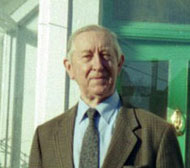Gloucestershire Society for Industrial Archaeology

During his time as curator of Stroud Museum in Gloucestershire. UK, Lionel Walrond took over 13,000 black and white photographs which he developed himself, but the majority of the negatives have remained unprinted.
At his death, in August 2020, the collection passed to Mr Robert Walrond, who has kindly permitted digitisation of the collection and granted a Creative Commons liecence for its non commerial use. More than 2300 negatives have been digitised, so far, and are available online here
The following obituary was written by Robert Walrond and is reproduced here with his permission.
A seven-year-old back-copy of a Somerset Archaeology Periodical may not have been typical reading for many 17 year old farmer’s sons in 1945, but it proved to be a life changing choice for Lionel Walrond. Lionel noticed the brief mention of the discovery of a Roman tile by farmer Herbert Cook whilst burying a dead sheep. Mr Cook’s farm at Low Ham was barely a mile from Lionel’s home at Glebe Farm, Pitney, and with Herbert’s permission, Lionel surveyed the site and decided on the spot at which he and a few friends would dig. Stopping for a flask of tea on the first afternoon, they noticed that as the sunlight dried the bottom of their trench, coloured mosaic became visible. They had come upon the head of the black horse being ridden by Aeneas – part of the Dido and Aeneas Roman Mosaic. The mosaic was to receive national attention, and has pride of place in the Museum of Somerset at Taunton.
Lionel Frederick James Walrond was born at Leigh on Mendip on 29th September 1927 to Frederick and Mary Walrond. His parents were tenant dairy farmers producing milk for local cheesemakers. It was not an easy start to life, Mary died when Lionel was only 3 weeks old, and Frederick was to die before Lionel’s 4th birthday. Lionel moved back to the Walrond family base at Glebe Farm, Pitney, Somerset, where he was raised by two aunts and an uncle. Childhood was spent labouring on the farm for his father’s brother, Percy.
Lionel did well at school and earned a place at Huish’s Grammar School in Taunton where he achieved an Oxford School Certificate and Exemption from the London Matriculation Board Examination. However, after leaving school after his 16th birthday Lionel felt deflated at the prospect of, in his words “a life of drudgery working for little return or appreciation on the farm. I did not enjoy farming, but gained a working knowledge of old ways of life, of geology, archaeology, old churches and architecture.”
His increasing archaeological knowledge led to the discovery of a further 2 significant Roman sites in South Somerset – both before Lionel’s 18th birthday! Lionel had begun collection old farm tools and household items which he meticulously labelled and displayed on the walls of a former US Army Nissen Hut that the farm had purchased for storing farm machinery.
Early influences included Kenneth Hudson, a writer and broadcaster with the BBC, who was a key player in Lionel’s fascination with social and industrial history and who encouraged Lionel to deliver talks and lectures. Sir Cyril Fox (former Director of the National Museum of Wales) was another early influence. After attending (at the age of 18) a lecture of Sir Cyril’s on old houses, Lionel described to him a cottage in his home village that he suspected of being a jointed or false cruck house. Sir Cyril insisted on being taken to see it. After the visit he told Lionel to write it up. “But I don’t know how” said Lionel. “Do a first draft and I will help” was the Sir Cyril’s reply. And he did. Lionel’s first paper became the first such report ever for the Somerset Archaeology Society.
Lionel had begun courting Olive Lazarus, a schoolteacher that he had met on an archaeological excursion, but they had agreed not to marry until he had obtained a museum post of some kind. Several applications had been sent off but, not having a degree, he was always rejected. Until Stroud Museum advertised to implement an improvement plan, that they were seeking a “recently retired curator”. Lionel dashed off an application, quoting as referee Dr F.S. Wallis of Bristol. The museum chairman contacted Dr Wallis whose reply was “grab him before he changes his mind”.
Lionel and Olive duly married in 1955, moved to Stroud and he began a 37-year tenure as Curator of Stroud Museum. It was a steep learning curve. Collections needed completing and updating, changes needed to be made -not least adapting the labelling so that priority was given to the object itself rather than its donor! Olive obtained a local teaching post, and helped Lionel by re-writing many of the exhibit labels. They happily enjoyed 49 years of marriage until Olive’s death in 2004.
One of Lionel’s notable achievements at the Museum was, in conjunction with Hugh Morrison, the development of a computer programme to record details of all 55000 items held by the Museum. A similar programme was produced by Microsoft a few years later.
Lionel was elected to the Fellowship of the Society of Antiquaries and to the fellowship of the Museum Association. In his lifetime he was a member of many societies including
Cotteswold Naturalists Field Club, Vernacular Architecture Group, Bristol and Glos. Archaeological Society, Glos. Building Recording Group, Glos. Industrial Archaeology Society, Somerset Archaeological and Natural History Society, British Agricultural History Society, Methodist History Society, Society for Folk Life Studies, Stroud Local History Society, Stroud Civic Society.
In retirement Lionel continued his passion for vernacular architecture by visiting many old buildings accompanied by his trusty canvas bag, camera and notebook. He co-wrote “The Cotswold House” with Tim Jordan, published in 2014, and continued to give talks on a variety of topics.
Lionel died peacefully on 4th August 2020 following a short period of ill health.
